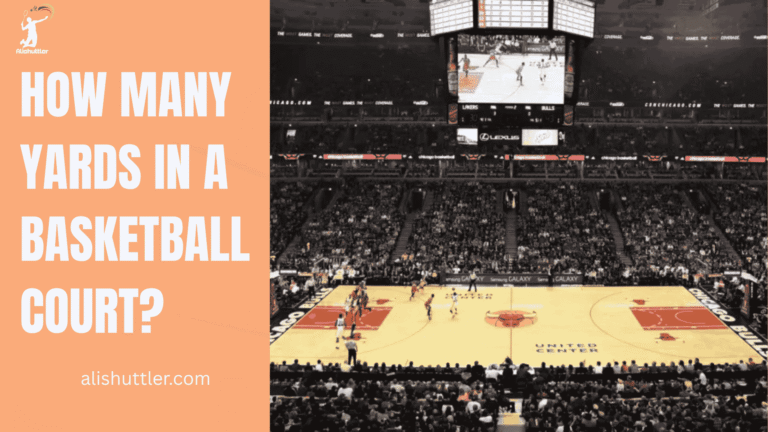The key in basketball is the painted area on the court near the basket, called the free throw lane or the paint. Most of the action takes place in or around this area, as players battle for rebounds, set screens and convert layups.
The key’s dimensions vary by league, but its usage is consistent. To assist you in understanding the principles and strategies of the key, the following sections dissect the specifics.
Anatomy of the Key
Key, sometimes referred to as the paint or lane, is the rectangular area of a basketball court underneath the basket. Defined by the baseline, free throw line and two lane lines, it is the key area for offense and defense. Its size and shape can vary by league, but its purpose remains the same: it controls player movement and serves as the setting for many crucial plays.

The key has evolved as well–it used to be a skinny ‘keyhole’ shape, just under two meters in width, and nowadays most tournaments utilize a rectangle, but the measurements still differ.
1. The Lane
The lane, a vital area of the key outlined by the lane lines, extends from the baseline to the free throw line. Most American basketball courts feature a lane about 4.88 meters wide, while FIBA courts measure 4.9 meters. This lane area restricts how long offensive players can remain, governed by the three-second rule, which is crucial in high school basketball and beyond.
Driving to the basket frequently relies on exploiting the lane. Players fly through it, using screens and cuts to lose defenders. Big men, or post men, attempt to work the paint for high-percentage shots. Defenders battle for position to prevent layups and rebounds.
Lane lines not only keep the action organized but also help referees in identifying violations during free throw attempts. Many second-chance points — a rebound followed by a quick put-back shot — happen within this area, making it a key scoring zone on the court.
2. The Circle
The free throw circle that sits at the top of the key has a radius of 1.8 meters. It designates where shooters have to stand on foul shots, and others have to remain beyond until the ball leaves the shooter’s hands.
The circle aids in maintaining spacing equitable. They line up outside the key/circle on free throws and only step in once the shot is taken. This arrangement prevents premature motion, which may provide an undue advantage.
The top of the key, just above the circle, is another popular place to initiate an offense — it provides nice sight lines and passing lanes. On free throws, the circle protects against lane violations. Offensive and defensive players must both remain outside the ‘paint’ until the shooter lets go of the ball, helping keep the play fair for everyone.
3. The Block
The block is a little painted square by the basket, right outside the lane. Post players used it to establish lay-ups or to protect their defenders.
Getting position on the block allows players to utilize their size to generate scoring opportunities, draw fouls or dish out to teammates. Players commonly employ the block to establish screens for shooters, to assist teammates in getting open.
Defensively, the block is where defenders post up, contest shots and box out for rebounds. A heads-up play on the block can turn around the momentum of a game, particularly in nail-biters.
4. The Restricted Area
The circle under the basket on which the restricted area is marked is a semicircle with a radius of 1.25 meters. We refer to this space as the no-charge zone. In this area, defenders cannot take charging fouls.
Rules here prevent defenders from camping under the hoop to obtain easy charging calls. This arc alters defenders’ coverage on drives, fostering more open, up tempo play. The restricted area assists prevent illegal blocks and maintains secure play close by to the rim.
Governing Rules
The key, commonly referred to as the restricted area or the lane, is one of the most highly governed areas in basketball. Its regulations govern attacking and defending motion, direct the pace of action, and demand continual supervision by officials. Understanding basic basketball terminology is essential for making games fair and fast at all competitive levels.
Offensive Violations
Offensive players can’t linger in the key for more than three seconds while their team has the ball in the frontcourt. This governing rule keeps teams from flooding the basket and allows both sides an equal opportunity to score. The three-second countdown doesn’t begin until the ball is in the frontcourt with the offensive team.
If an offensive player lingers too long, the team forfeits possession. Players have to get out of the key and get back in the key to reset the count. These infractions can disrupt a team’s flow, put a halt to scoring streaks, and drive hasty choices amid congestion.
To avoid offensive violations, teams often:
- Use quick passes and off-ball screens to keep them moving.
- Well-designed plays that draw defenders away from the paint, creating room for cutters.
- Teach big men to ‘mark and dart’ or step out to the open area.
- Establish obvious cues for players to rotate out of lane after 2 seconds.
- Emphasize alertness during fast breaks or broken plays, when loitering in the key is most prevalent.
Defensive Violations
Defensive 3 second violations prevent defenders from camping in the paint unguarded. In most pro leagues, defenders can remain in the key for three seconds only if they are closely guarding a player. The count freezes if the defense is contesting a shot, the ball is loose or the defender is out of the lane.
Penalties for violations are a free throw and ball to offense, which can turn momentum. Defenders should know where their man is and how to assist without camping in the key. Cues—screams for screens, switches and rotations—get us out of the basic errors.
Defensive rules compel teams to play honest defense, which in turn opens up driving lanes and mid-range shots.
Free Throws
Shooting free throws depends on the key. The shooter is positioned behind the free throw line and other players are on the blocks outside the key. The free throw circle prevents defenders from jamming the shooter.
Making it at the line is frequently about concentration and dealing with pressure because free throws determine tight contests. Major fouls—such as jumping the lane or stepping across the line—result in either lost points or bonus opportunities for opponents.
Referee Enforcement
Referees must observe every second of action in the restricted area basketball. Their calls on three-second violations, lane entry, and dribbling errors uphold the integrity of the game, ensuring fast, equitable decisions that maintain pace and keep teams honest.
Strategic Battleground
The key, or the paint, is where a bulk of a basketball game’s action takes place. That painted rectangle under the basket is a strategic battleground. Both teams concentrate here, for possession of the key can determine the offensive or defensive tempo. The key’s shape and size vary by league and level, but its strategic importance remains.
Three-second rule and restricted area arc influence how players utilize this space. Teams that figure out the key frequently dominate the game.
Offensive Focus
Many offensive sets initiate in or flow through the key. It’s the area nearest the hoop, therefore teams utilize it to obtain high-percentage shots. Players who are good at banging in the paint can attract defenders and create opportunities for teammates.
Ball movement, spacing—it all matters. Fastball passes, angle cuts, and power screens yank defenders off their positions and open shooting lanes. Good spacing stretches the defense providing the offense more operating room.
Perimeter players, including guards and wings, exploit drives into the key to initiate rotations and kick out to open teammates. When teams space well and move the ball quick, the elbow becomes a strategic battleground.
Defensive Fortress
Defensively, the key serves as a fortress. Teams want to defend this zone at all costs, making it hard for opposing players to drive to the basket and score. Defenders utilize both zone and man-to-man schemes to guard the paint.
Zone defense players defend areas, frequently packing the paint to clog driving lanes. With man-to-man, defenders follow their individual assignments, hounding easy post entries. Communication is vital for defenders.
Calling out screens, switches, or cutters can help avoid breakdowns. Positioning and anticipation count. Players like centers and power forwards who read plays well and contest shots can turn the tide of tight games.
Player Positioning Strategies
- Front the post to deny easy entry passes.
- Box out aggressively after shots to control rebounds.
- Keep moving, sliding with the ball but not committing the three-second violation.
- Take advantage of the limited area arc to take shots or dodge fouls.
Enhancing Team Strategy
Knowing how much a key is worth allows coaches and players to devise more intelligent strategies. Teams that know when to attack the paint or pack it in on defense get a real advantage.
Adjusting to rule changes and making good use of the key’s space distinguishes the great teams from the good.
Historical Evolution
The key, often called the restricted area or the lane, has evolved significantly since basketball’s inception, influencing team play and the establishment of important basketball rules.
The Original Shape
Basketball’s original key resembled a keyhole, with a narrow, 1.8-meter-wide rectangular lane that terminated in the free throw circle. This condensed area created difficulty for players to dribble, resulting in increased physical play in proximity to the basket. Teams packed the paint, and big men hovered around the rim to dominate boards and easily convert, especially in the restricted area basketball.
The way the original key in basketball was configured compelled teams to depend on set plays and shots nearby. Player positioning was easy: feed the big man under the basket. Tactics involved less movement and more about employing size and strength. This design suited the sport’s nascent rules, which by no means yet accounted for the athleticism and girth of players to come, particularly on basketball courts.
The key’s narrow shape had become a focal point as basketball evolved. The 1893 rule change, merely two years after the sport was invented, indicated how rapidly the region was gaining significance. The relocation of the free throw line from 6.1 to 4.6 meters in 1895 was yet another early tweak, setting up the key as a hot spot for both activity and rule innovation.
The Widening key in basketball
As the key in basketball became more popular, the original narrow key allowed dominant players such as George Mikan to take over games in the early 20th century. This caused rule-makers to expand the key, initially in the NBA and eventually in FIBA play. The lane expanded to 3 meters, creating more room and more difficulty for big men to lurk under the basket.

The three-second rule was incorporated to prevent players from lingering in the key, thereby encouraging teams to pass and generate additional opportunities. Wider keys altered the entire game from offense to defense. Guards and wings had more room to drive, but defenders had to defend more space.
The trapezoidal key used by FIBA, from mid-century until 2010, was another effort to equalize play internationally. When FIBA converted to a rectangular key in 2010, it was a nod to internationalization and standardization. Including the “no charge zone” in the 1997-1998 NBA season, and glass backboards in 1910, demonstrated how much player safety and fair play counted.
These transformations, along with the expanded key in basketball, sculpted modern basketball into a quicker, more-permeable game with more-distributed scoring.
Modern Context key in basketball
Today, the key is rectangular, 4.9 meters wide in the NBA and 4.8 meters in FIBA games. The restricted area arc, introduced for player safety, prevents defenders from sinking charging fouls too near the basket.
These changes are indicative of a game that prioritizes fast, skilled, and fair play at every echelon.
Global Dimensions
Basketball is played worldwide, yet the key rectangular area beneath the hoop, known as the restricted area, doesn’t appear uniform in all locations. Various leagues employ different court dimensions and shapes for basketball courts, and these specifics affect how games are played. Understanding these disparities matters for players, coaches, and fans looking to observe how the game transforms across countries or leagues.
NBA
The NBA key marks, which are integral to the court dimensions, are 4.88 meters (16 feet) wide and 5.8 meters (19 feet) from the baseline to the foul line. The basket is strategically positioned 1.2 meters from the baseline, with a semicircle featuring a radius of 1.83 meters (6 feet) from the foul line. These stat lines maintain a blazoned pace and a frenzy of paint, crucial for both offensive and defensive strategies on the key in basketball courts.
| Feature | NBA Key Dimension | Impact on Play |
|---|---|---|
| Width | 4.88 m (16 ft) | Space for strong post play |
| Depth (Baseline-Foul) | 5.8 m (19 ft) | Longer drives and more room to attack |
| Basket setback | 1.2 m (almost 4 ft) | Influences rebounding and shot angles |
| Semicircle radius | 1.83 m (6 ft) | Governs charge/block calls |
The NBA key significantly influences how professional teams organize their offense and defense. With fewer players in the restricted area, big men can operate for deep position, while defenders have room to assist. This dynamic creates battles near the rim and opens up shooters when defenses collapse, making quick drives and powerful dunks a common sight in high school key in basketball and professional arenas alike.
FIBA
In FIBA play, the court dimensions feature a key that is 4.88 meters (16 feet) wide and fully rectangular, with the foul line positioned 5.8 meters (19 feet) from the baseline. Before 2010, FIBA utilized a trapezoidal key, which was wider at the baseline and narrower at the apex, significantly changing how teams attacked and defended. The modern rectangle mirrors the NBA’s design but is applied internationally, particularly in tournaments like the Olympics, where the typical basketball court measures 28m x 15m.
| Feature | FIBA Key (Current) | NBA Key | Difference |
|---|---|---|---|
| Width | 4.88 m (16 ft) | 4.88 m (16 ft) | Same |
| Depth | 5.8 m (19 ft) | 5.8 m (19 ft) | Same |
| Shape | Rectangle | Rectangle | Same (since 2010) |
| Pre-2010 Shape | Trapezoid (6m x 3.6m) | – | Wider at baseline |
Players transitioning between FIBA and other leagues must adapt to minor adjustments, such as the tip-off circle’s diameter being 3.5 meters instead of six feet. These adjustments affect how teams use space on the court. While the universal rectangle implemented in 2010 aids in standardizing play, the unique characteristics of the FIBA court, including its earlier trapezoid free throw lane, have inspired innovative zone and fast-break strategies.
NCAA
The NCAA key is 4.88m (16ft) wide, the same as the NBA and FIBA. The free throw line is 5.8m from the baseline too. College courts are a little smaller overall, typically 28.65 meters (94 feet) long x 15.24 meters (50 feet) wide.
- NCAA rules restrict defensive time in the paint, so big men can’t merely lurk beneath the rim. This forces players to slide and switch making defense more dynamic.
- That key’s dimension implies post play is still significant, though with faster rotations and abundant help defense, scoring in close is challenging for most college squads.
College key in basketball provides players a thrill of professional basketball spacing. It teaches future pros how to make split-second decisions in congested areas, footwork, and how to read defenses. The key lays the foundation for aggressive defensive strategies and instructs athletes to utilize timing and positioning to create shooting opportunities.
International Implications
Different key sizes make the players more versatile. They learn to play in both wide and narrow paint, modify footwork, and read defenses differently.
Standardizing the key helps even the playing field for international games. It ensures that teams from any country understand what to expect when they go to compete, which is good for fairness and promotes growth in the sport.
The Modern Key
The key, or paint, is a region in the middle of the key in basketball court. While it’s now rectangular for most major leagues, it’s 4.88 meters wide in NBA and FIBA games, and 3.66 meters wide for the NCAA. The way its shape transitions from the old “key” look to a full rectangle and its changes in width mirror how the game has evolved towards favoring different styles and strategies.
Analytics, player skill development, and new spacing ideas all influence how teams utilize the key today.
Analytics for key in basketball
Analytics allows teams to deconstruct what goes on inside the key in specific, quantifiable ways. Coaches and analysts monitor player movement, shooting percentages and shot types to determine who scores most effectively near the rim. Teams today depend on this information more than ever to strategize where and how to play offense or defense in the key.
Shot efficiency is a priority. For example, squads discover that a layup or dunk inside the key is nearly always a higher percentage shot than a long two at the top of the key. Data reveals that corner threes that get a head start near the edge of the key are percentage-wise more successful than midrange shots near the top.
Coaches use these stats to assist players in identifying their optimal shooting locations and assisting rapid decision-making during games. Analytics even impact player positioning, with figures directing coaches to position taller or more nimble players in specific locations to increase both offensive and defensive potential.
Player Evolution
So player’s use of the key has evolved as the game has become faster and more athletic. Today’s players are faster, stronger and more skillful than ever, allowing them to attack the basket and defend the rim with more ferocity.
The transition from the old trapezoidal FIBA key to a rectangle speaks to this new style’s need for more space. Utility guys now occupy several positions in the key. Centers and forwards can step out to shoot, guards often drive in and finish against defenders.
Evolving with this transition is crucial for squads that seek to stay up. That is, defenders need to be prepared to rotate and respond, rather than simply cover an area.
Spacing key in basketball
Spacing is crucial key in basketball, ensuring players aren’t clumped together too closely, particularly near the restricted area. Proper spacing creates driving lanes and facilitates passing and scoring, allowing teams to spread out effectively and cause defenders to cover more ground. This results in cuts, open shots, or fewer turnovers, which is essential in high school basketball and other competitive levels.
By spacing players out, ball movement remains fluid, forcing defenders to choose between protecting the paint or closing out on shooters. This strategy highlights the importance of the three-point line that intersects the top of the key, impacting scoring opportunities significantly. Teams often occupy the area around the key to initiate screens and pick-and-rolls, setting up advantageous mismatches.
Additionally, maintaining proper spacing helps teams adhere to regulations like the three-second violation. By being aware of player locations, teams can keep the offense flowing, preventing costly turnovers and enhancing overall performance on the court.
Trends

key in basketball continues to evolve as new trends and regulations sculpt the game, including changes to court dimensions and markings.
Final Thoughts on key in basketball
The key defines much of what makes key in basketball tick. It establishes the floor for quick cuts, tough shots, and rapid fire shots. They understand how much can shift within a few strides in that red zone. Teams employ the key to defend, score, and tilt the contest their direction. From its inception to today, the key remains a distinct symbol of the game’s evolution.
Courts around the world display the key as a symbol of good sportsmanship and clever strategy. For those of you interested, watch a game and notice how much action takes place in the key. Post your own thoughts or queries about the key–every view adds to the story.
Frequently Asked Questions
What is the key in basketball?
The key, often referred to as the restricted area or free-throw lane, is the rectangular area beneath the basketball hoop, crucial for both high school basketball and professional play.
Why is the key important in basketball strategy?
The restricted area is a hotbed of scoring and defensive plays; mastering basketball basics here is often the key to winning the game.
What are the main rules for the key in basketball?
Players can’t camp out in the restricted area for more than three seconds while their team is on offense; breaking this rule results in a turnover.
How has the key changed throughout basketball history?
The key has been resized and reshaped to prevent towering players from dominating high school basketball. These alterations assist in balancing offense with defense on typical basketball courts.
Are the key’s dimensions the same worldwide?
No, the key can vary in size; for instance, FIBA basketball courts feature different dimensions compared to NBA courts.
What is the “paint” in basketball?
The paint, or restricted area basketball, refers to the key marked on the court floor that outlines this important playing area.
How does the key impact player positioning?
Key positioning on basketball courts influences players’ roles on offense and defense.






